Published Nov 13, 2015
Hallmark Sculptor Lynn Norton on the Storied History of Trek Keepsake Ornaments
Hallmark Sculptor Lynn Norton on the Storied History of Trek Keepsake Ornaments
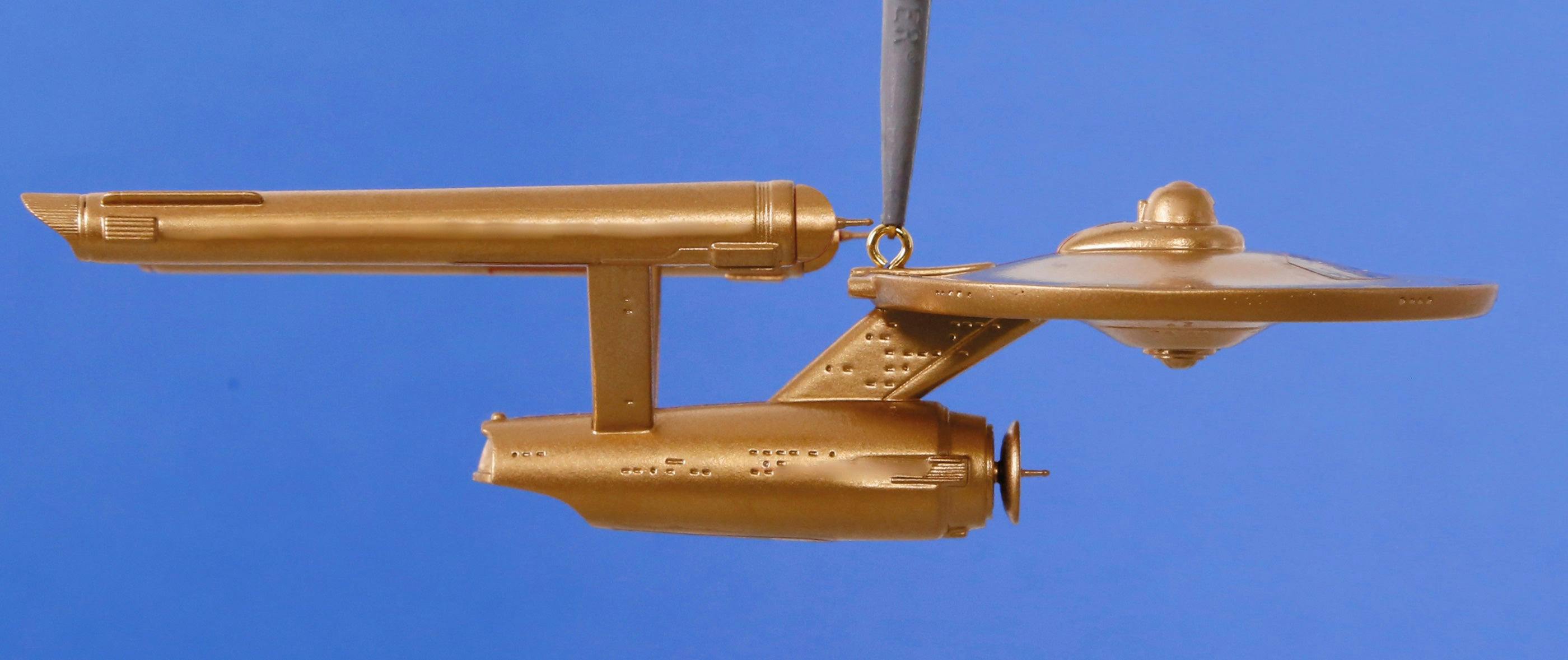
After 50 years, the distinctive image of the USS Enterprise has come to serve not only as home for hundreds of explorers of the future but also as an iconic symbol of the Star Trek universe and all that represents to its fans. For more than half that time, sculptor Lynn Norton has devoted uncounted hours to interpreting incarnations of the beloved starship, creating Keepsake Ornaments for Hallmark that bring fans’ favorite memories and fantastic moments to Christmas trees each year (and admittedly to collectible displays all year long for many people).As many fans’ thoughts turn to decorating for the holidays, Lynn shares his thoughts not just on his appreciation for starship designers but his own joy in helping fans celebrate with ornaments of the good ol’ NCC-1701 — and bloody A, C, D and E (just not B).“I consider the ships I have sculpted to be like characters rather than objects,” he says. “Each is recognizable, and almost as specific as a human face. I’m looking at them as a fan, of course — I’ve been watching since the first broadcast—but also as a sculptor who appreciates their beauty and qualities as icons.”1991 — Starship Enterprise
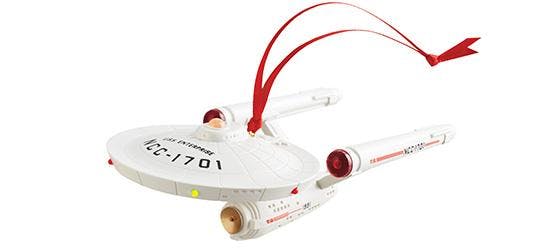
“From the beginning, Star Trek imagined that we had overcome the problem of a ship having enough energy not only to propel yourself but to give yourself a comfortable living environment. As a design, it captured our excitement from the notion of flying saucer and the way we had come to imagine what a deep-space vehicle might look like. When you start thinking of the physics of propelling an object through space, it doesn’t have to look aerodynamic. It can be purely functional. The fact that it was a flying saucer is one of the things that captured my imagination right away. All space movies are really submarine movies. The Enterprise reflects all the elements of a submarine crew’s experience — living in close quarters in a hostile environment with nothing but a thin metal skin between them and oblivion — and put it in space seamlessly.
“At Hallmark, Don Palmiter, Dill Rhodus and I brought fine scale model-making to the ornament business. We really had to convince our art directors we could go beyond cute and traditional and make really believable small models to be used as ornaments. Our commitment to high quality fit right into the Hallmark ideals for product. Now, I also had to fight the initial idea of having a string of garland hanging along the edge of the primary hull, and Santa Claus popping out of the bridge — true story! I wanted to make it as accurate as possible. I’m very aware of the changes to that first ornament. Because it had big, thick circuitry inside for lights, the ornament had heat dissipation problems. We had to build a big cavity into it so the circuit board would not melt the plastic. Also, the ornament had to fit into a ‘printer’s box’ store display with a limited space, and I had to shorten the nacelles for it to fit. I beat that poor design nearly to death, but it got us started and it was very popular with fans of Star Trek and of Keepsake Ornaments. When we reissued the ornament in 1996 for the show’s 30th anniversary, we used the same design.”1993—USS Enterprise NCC-1701-D
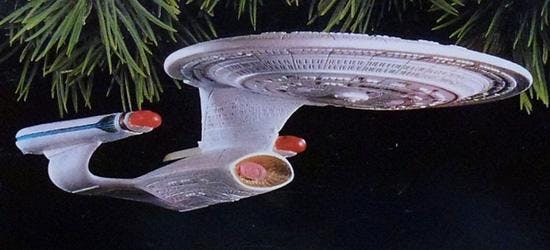
“At the time, Paramount would send me original blueprints and photos of the filming model as it was being constructed. I had access to detail that wasn’t readily apparent on our TV sets in those days, and I was able to explore and appreciate the design. I always imagined how I wanted to be part of the teams that built those studio models. It was thrilling for me to see the materials they were sending me. What appealed to me most was the level of detail visible on the hull and nacelles. The original was very simplistic in nature, and I had no problem with that. On the D, everything was busy. “The Aztec patterns on the hull caused us some concern. What people are imagining on these end products is an extension of what happens in real life. Much of the hull plating is prefabricated and painted at the factory and there are little bits of variation in the paint lots, so there is a small difference in tone for each plate. Also, as plates go over curves, reflectivity changes. It happens on metal aircraft, so we’re familiar with seeing it. Even if you have no paint, the fact that metal when formed will change its lighting characteristics just slightly enough that it ends up with a patchwork look. But on an ornament, capturing that look can add literally hundreds of decoration steps, whether spray masks or pad printing or however you choose to do it. We chose not to.”1998—USS Enterprise NCC-1701-E
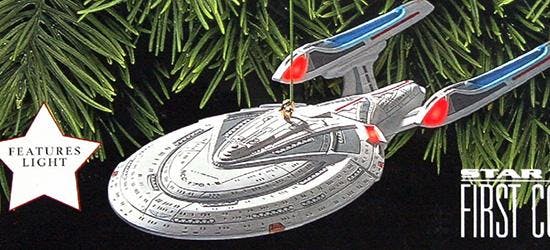
“I adore the E. They did things to it to make it look more aerodynamic than it needed to be, but those choices gave it more style—a more swept-back, speedy appearance like a modern race car. “There were a lot of products out there being developed right along side the model during (Star Trek: First Contact’s) production. I was getting the same photos from the studio as everyone else was, and originally the E had a blue-glowing deflector array. We went to see the movie and there’s that whole scene set on the deflector array and they’re out there walking around on it—and it’s amber! I was like ‘What the?’ But we were able to make that change while the ornament was in development at the toolmaker. Because it didn’t go to stores right away, our ornament was one of the few screen-accurate products on the market at the time.”2002—Enterprise NX-01
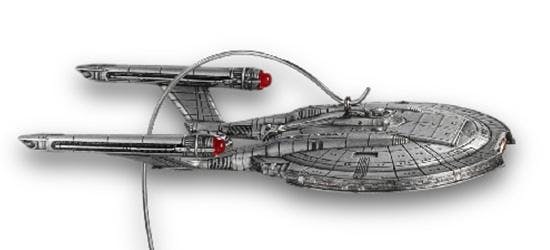
“It’s a very cool ship. In my mind, it typified what a starship should look like even more so than the original Enterprise. I always had a bit of a problem with a primary hull and this secondary hull sticking out from it and then your engines are way in the air on these pylons. I always imagine that there is something happening in these engines that would harm the crew, so you want them as far away from the crew and even the engineering section as possible. The NX-01 was integrated. It is sculpturally more pleasing to me.“We did that ornament in diecast metal to save time. The show was airing on television and we wanted to get it into the marketplace as fast as possible. We didn’t have the long development time that we need for a lighted, mechanical ornament. This one was nickel-plated zinc that gives it added value for the price, and it looked a lot like the skin of the ship. I really like the looks of it. I’ve heard a few complaints over time about our not doing one that was lighted, but we did have dialogue from Scott Bakula that played from a display base.” 2005—USS Enterprise NCC-1701-A
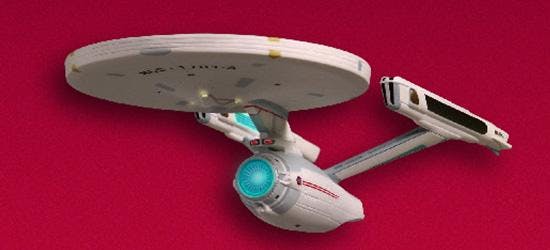
“I loved the very dramatic unveiling of that ship in Star Trek: The Motion Picture. I’ll never forget the awe I felt from seeing it on the big screen. That was the first time we ever had seen it like that, and it was detailed out for us to see in all its glory. Fans wanted it, too. There was a campaign petitioning Hallmark for several years requesting it. ‘You need to do that ship!’“Originally, our ornament of the A was planned as our last starship with a cord for power, but the design had to be shifted to battery operation or it wasn’t going to pass UL (Underwriters Laboratories) specifications. That’s why my sculpt has those awful tree-trunk pylons to support the nacelles; they had to be big enough to house the wiring to satisfy UL. Since then, every ship has been battery-operated.”2006—USS Enterprise NCC-1701
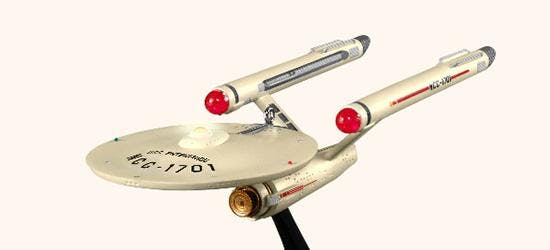
“Look at the original Enterprise and you see basic geometric shapes. Almost everything on that original ship, I can execute on my miniature lathe and miniature mill. As we start moving through more complex designs, there became fewer and fewer things I could make on the lathe. They became more oval-shaped, there were detailed ridges and recesses that didn’t appear that much on the original Enterprise except for the interior of the nacelles. They added details to the models as time went on.”“This was my more accurate sculpting of the original ship design. It felt redemptive in that I was able to get it closer to scale. There is a difference in end product versus what I sculpted because of the process to build a master pattern that is used to cut the molds. You end up with process shrinkage and distortion, and in 2006, that didn’t make me happy. The saucer got too thin. They weren’t able to keep the nacelles properly aligned to the center axis. It’s not just us. That’s been a problem for every manufacturer who makes this ship into a consumer product. I just wanted to do something a little different than I had done before.”2007—USS Enterprise NCC-1701-D (Future)
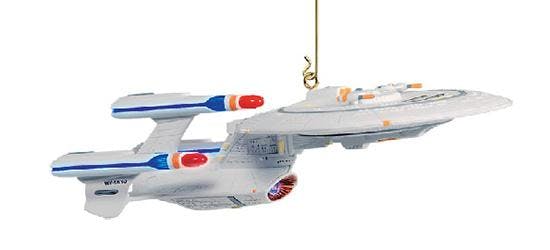
“The triple-nacelle ornament from (the Star Trek: The Next Generation episode) ‘All Good Things…’ was based on my original sculpture from 1993. Hallmark allows artists to retain original artwork for our portfolios, although the sculptures are often badly damaged from the process of molding and prototyping. The licensor supplied me with a number of photographs of the filming model as it was being refitted with additional components. In addition to adding the third nacelle and battle-bridge modifications, I made numerous proportional adjustments and refinements to the sculpture. I knew the 2007 ornament would be battery powered and wouldn’t have to pass the rigorous UL tests for tapping electricity from a light string. I still had to make provisions for LED placements, wire paths and battery installation, which included an access door on the underside of the saucer.”
2010—USS Enterprise NCC-1701 (alternate timeline)

“I was happy with that design and the way it turned out. My original sculpture is smaller than the actual ornament. As we anticipated the circuitry and the size of the battery pack, when they started building the molds they realized that the secondary hull wouldn’t be big enough to house the batteries. I must give my art director credit for this, as rather than fattening the hull to fit the batteries, he instructed them to upsize the entire ship so it would maintain more accurate dimensions.” 2012—USS Enterprise NCC-1701-D

“Since I previously made adjustments to my original 1993 sculpture for the 2007 issue, I utilized the revised sculpture from 2007 as a basis for the 2012 anniversary edition. I removed all of the additions and restored the D to its original configuration. We decided to place the ornament on a display base so it could have sound in addition to lights. With that in mind, the control circuitry, batteries and speaker would all be housed in a base that is permanently attached, unlike the detachable bases on previous ornaments.”2015—USS Enterprise NCC-1701-C

“I had this ship on my short list for years. The ornament has got a kick-ass lighting effect. I know there was some conversation among fans as to our releasing it with a pristine look rather than having some battle damage as depicted in the (TNG) episode “Yesterday’s Enterprise.” My vote was to make it pristine. While I’m thrilled that Star Trek fans like our products, we have to keep the Hallmark shopper in mind as our primary consumer. When you put something in the store that appears battle-damaged, to them, it looks dirty. They don’t know the backstory and in many cases they don’t care as they likely are buying these as a gift for someone who is a fan. That fan will appreciate the detail and pore over it, but at the point of purchase, the buyer needs to be attracted to it. In my mind, I like reserving the battle-damage look for reissues or as event exclusives.”2016—USS Enterprise NCC-1701
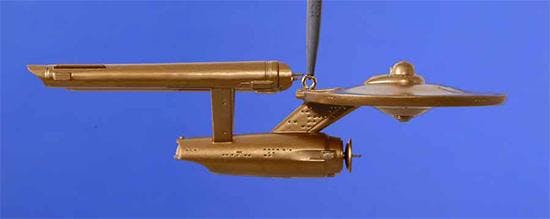
“This is the one that I really went out of my way to make as accurate as possible. I based it on the original shooting model with its larger bridge dome, larger deflector dish and nacelle features as a tribute to the series’ 50th anniversary. Assuming it’s able to maintain all of its details in final production, it’s more accurate than anything I’ve done before.“One thing to note in the progression of all of Hallmark’s Star Trek ornaments. People will ask why ornaments are so much better looking now than in the past. Some of that is owed to advancements in technology. Some of that comes from the learning curve for me, and some is the learning curve for the manufacturer and mold makers. Twenty-five years ago when we started making the Enterprise, to that point we had been making cute, fuzzy bunnies and such. Now, we’re known for the work that we do on all designs. Because of my technical background and my background as an engraver, I was pushing the limits of what I understood the limits of the manufacturing process to be. And we keep getting better every year.”
_____
As a journalist for more than 25 years, KEVIN DILMORE has contributed to publications including the Village Voice, Amazing Stories, Star Trek and Star Trek Communicator magazines as well as web sites including Hallmark.com and Star Trek.com. His essays on popular culture have been published in anthologies by Sequart and Crazy 8 Press. Kevin has teamed with author and best pal Dayton Ward for 15 years on novels, shorter fiction and other writings chiefly within the Star Trek universe, including their latest novel in the Star Trek: Seekers series, All That’s Left, published by Pocket Books in November. By day, he works as a senior writer for Hallmark Cards in Kansas City, Mo. A graduate of the University of Kansas, Kevin lives in Overland Park, Kansas.
